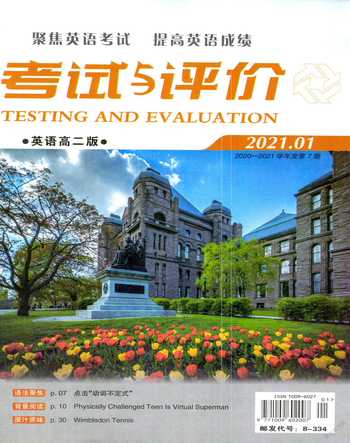点击“动词不定式”
2021-09-10李健
李健
不定式的用法不仅是高中语法的重点和难点,也是高考考查的热点。动词不定式是非谓语动词的一种,在句中起名词、形容词或副词的作用,同时也保留了一些动词的特征,可以带宾语或状语。本文就不定式的高考考点,拟谈其主要用法与功能,以帮助大家复习、巩固这一考点。
◆ 不定式的形式
不定式的肯定形式是由“to+动词原形”构成。其否定形式是“not to+动词原形”,若要加强语气可用“never to+动词原形”。
◆ 不定式的时态
1. 一般说来,不定式一般式表示的动作有时与限定动词表示的动作同时发生,也有时发生在限定动词表示的动作之后。如:
Who heard him say that? 谁听到他说那件事了?
He seems to know this. 他看上去知道这个。
I hope to see you again. 我希望再看你一次。
2. 不定式进行式表示动作正在进行,通常与限定动词表示的动作同时发生。如:
They are said to be building another bridge across the river. 据说他们要再建另一座穿过这条河的桥。
I happened to be going that way too. 我正好也往那边走。
3. 不定式完成式表示的动作发生在限定动词表示的动作之前。如:
I am sorry to have given you so much trouble. 我很抱歉给你带来这么多的麻烦。
I am glad to have seen your mother. 我很高兴见到了你的母亲。
◆ 不定式的句法功能
1. 不定式作主语
To talk with him is a great pleasure. 跟他交谈很愉快。
不定式短语作主语时,为了保持句子的平衡,往往以it作形式主语,而把不定式短语置于谓语动词之后。如:
Its nice to hear your voice. 听到你的声音真是太好了。
2. 不定式作表语
Her wish is to become an artist. 她的愿望是成为一个艺术家。
3. 不定式作宾语
常用于及物动词want, hope, wish, like, need, hate, offer, prefer, begin, start, attempt, decide, determine, expect, promise, pretend, refuse, afford, manage, help等之后。如:
You should continue to learn as long as you live. 你应该活到老学到老。
注1:如果作宾语的不定式又有自己的补语,则须用先行词it 作形式宾语,而将真正的宾语不定式后置。如:
They found it impossible to get everything ready in time. 他們发现要及时把所有东西都准备好是不可能的。
注2:不定式一般不能作介词的宾语,只有在极少数介词如but, except等后边才行。此时不定式可以带to或不带to。如:
In very cold winter weather a cold-blooded animal has no choice but to lie down and sleep. 在寒冷的冬天冷血动物除了睡觉也没有其他的选择了。
There was nothing left to do but clean the windows. 除了清洁窗户没什么可做的了。(前边有do,to省略)
但“疑问词+不定式”结构可以作介词的宾语。如:
I have no idea about what to do next. 我也不知道接下来应该做什么。
4. 不定式作宾语补足语
通常用于及物动词或动词短语want, wish, ask, order, beg, tell, permit, know, help, advise, persuade, allow, prepare, cause, force, require, call on, wait for等之后。如:
The teacher asked the students to hand in their homework. 老师让学生们把作业交上来。
5. 不定式作定语
不定式作定语时,须放在被它修饰的名词或代词之后。被修饰的名词或代词往往是不定式的逻辑宾语。如:
I have a lot of work to do. 我有很多工作要做。
当作定语的不定式所修饰的名词或代词是不定式动作的承受者时,不定式既可用主动语
态,又可用被动语态,但其含义有所不同。所以如果修饰名词的不定式的动作是主语作的, 不定式用主动语态。
试比较:
Have you anything to send? 你有什么东西要寄吗?(不定式to send的逻辑主语是you)
Have you anything to be sent? 你有什么要(我或别人)寄的东西吗?(不定式to be sent的逻辑主语是已被省略的me或someone else)
Ive got letters to write. 我有一些信要写。
He has something to say to you. 他有事情要跟你说。
6. 不定式作状语
作修饰动词的目的状语。
We must do everything we can to help them. 我们要竭尽全力帮助他们。
作修饰动词的结果状语:加强意料不到的语气,在表示结果的不定式前还可加only。如:
I went to see him only to find him out. 我去找他结果发现他出去了。
作修饰表语形容词的状语:修饰形容词的不定式用主動形式。如:
The chair is comfortable to sit in. 这个凳子坐起来很舒服。
作结果状语或程度状语。
too+adj. / adv.+to do 太……(以致)不能(做)……
It is too dark for us to see anything in the room. 房间里太黑了,什么也看不见。
adj. / adv.+enough+to do ……足以(做)……
Is the boy old enough to go to school? 这个男孩的年龄可以去上学了吗?
7. 不定式作独立成分
To tell you the truth. 跟你说实话。
To cut a long story short。长话短说。
To begin with... 首先……
不定式的复合结构“for+名词(或代词宾语)+to do sth.”。
这种结构中的for本身无意义,for后的名词或代词(宾格)是不定式的逻辑主语。如:
This is for you to decide. 这个要由你来做决定。
句型1:It is + for sb. to do sth.
句型2:It is + of sb. to do sth.
中间可以加的形容词有good, kind, nice, wise, unwise, clever, silly, stupid, foolish, right, wrong, rude, impolite, careless, naughty等。
◆ 不定式省去to的情况
1. 当两个或两个以上的不定式并列在一起时,第一个不定式带to,后面的不定式往往把to
省去。如:
I wished to finish my homework and (to) get away. 我希望完成作业以后就离开。
但是,如果是在对照的场合,则不可以省去“to”。如:
It is better to laugh than to cry. 笑比哭好。
2. 在感官动词see, hear, feel, watch, notice, observe, listen to, look at和使役动词let, make, have的复合宾语中,不定式须省去to。如:
I am a doctor. Let me examine you. 我是个医生,让我给你检查一下。
3. 在help的复合宾语中,不定式可以带to也可以不带to。如:
He often helps me (to) do my homework. 他经常帮助我做作业。
4. 在had better, had best, would rather, would rather... than, cannot but等句型中通常省略to。如:
Youd better remain where you are. 你最好待在原地。
